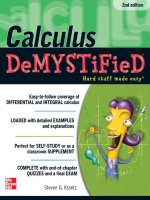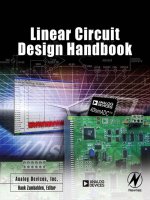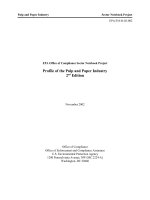Calculus DeMYSTiFieD (2nd edition)
Bạn đang xem bản rút gọn của tài liệu. Xem và tải ngay bản đầy đủ của tài liệu tại đây (3.25 MB, 416 trang )
Calculus
DeMYSTiFieD®
..................................................................................................................................................
/>
DeMYSTiFieD® Series
Accounting Demystified
Advanced Calculus Demystified
Advanced Physics Demystified
Advanced Statistics Demystified
Algebra Demystified
Alternative Energy Demystified
Anatomy Demystified
asp.net 2.0 Demystified
Astronomy Demystified
Audio Demystified
Biology Demystified
Biotechnology Demystified
Business Calculus Demystified
Business Math Demystified
Business Statistics Demystified
C++ Demystified
Calculus Demystified
Chemistry Demystified
Circuit Analysis Demystified
College Algebra Demystified
Corporate Finance Demystified
Data Structures Demystified
Databases Demystified
Differential Equations Demystified
Digital Electronics Demystified
Discrete Mathematics Demystified
Earth Science Demystified
Electricity Demystified
Electronics Demystified
Engineering Statistics Demystified
Environmental Science Demystified
Everyday Math Demystified
Fertility Demystified
Financial Planning Demystified
Forensics Demystified
French Demystified
Genetics Demystified
Geometry Demystified
German Demystified
Home Networking Demystified
Investing Demystified
Italian Demystified
Java Demystified
JavaScript Demystified
Lean Six Sigma Demystified
Linear Algebra Demystified
Logic Demystified
Macroeconomics Demystified
Management Accounting Demystified
Math Proofs Demystified
Math Word Problems Demystified
MATLAB® Demystified
Medical Billing and Coding Demystified
Medical Terminology Demystified
Meteorology Demystified
Microbiology Demystified
Microeconomics Demystified
Nanotechnology Demystified
Nurse Management Demystified
OOP Demystified
Options Demystified
Organic Chemistry Demystified
Personal Computing Demystified
Pharmacology Demystified
Physics Demystified
Physiology Demystified
Pre-Algebra Demystified
Precalculus Demystified
Probability Demystified
Project Management Demystified
Psychology Demystified
Quality Management Demystified
Quantum Mechanics Demystified
Real Estate Math Demystified
Relativity Demystified
Robotics Demystified
Sales Management Demystified
Signals and Systems Demystified
Six Sigma Demystified
Spanish Demystified
SQL Demystified
Statics and Dynamics Demystified
Statistics Demystified
Technical Analysis Demystified
Technical Math Demystified
Trigonometry Demystified
UML Demystified
Visual Basic 2005 Demystified
Visual C# 2005 Demystified
XML Demystified
Calculus
DeMYSTiFieD®
..................................................................................................................................................
Steven G. Krantz
Second Edition
New York Chicago San Francisco Lisbon London Madrid Mexico City
Milan New Delhi San Juan Seoul Singapore Sydney Toronto
Copyright © 2011, 2003 by The McGraw-Hill Companies, Inc. All rights reserved. Except as permitted under the United States Copyright Act
of 1976, no part of this publication may be reproduced or distributed in any form or by any means, or stored in a database or retrieval system,
without the prior written permission of the publisher.
ISBN: 978-0-07-174364-8
MHID: 0-07-174364-2
The material in this eBook also appears in the print version of this title: ISBN: 978-0-07-174363-1,
MHID: 0-07-174363-4.
All trademarks are trademarks of their respective owners. Rather than put a trademark symbol after every occurrence of a trademarked name,
we use names in an editorial fashion only, and to the benefit of the trademark owner, with no intention of infringement of the trademark. Where
such designations appear in this book, they have been printed with initial caps.
McGraw-Hill eBooks are available at special quantity discounts to use as premiums and sales promotions, or for use in corporate training
programs. To contact a representative please e-mail us at
Information in this book has been obtained by The McGraw-Hill Companies, Inc. (‘‘McGraw-Hill”) from sources believed to be reliable.
However, neither McGraw-Hill nor its authors guarantee the accuracy or completeness of any information published herein, and neither
McGraw-Hill nor its authors shall be responsible for any errors, omissions, or damages arising out of use of this information. This work is
published with the understanding that McGraw-Hill and its authors are supplying information but are not attempting to render engineering or
other professional services. If such services are required, the assistance of an appropriate professional should be sought.
TERMS OF USE
This is a copyrighted work and The McGraw-Hill Companies, Inc. (“McGrawHill”) and its licensors reserve all rights in and to the work. Use
of this work is subject to these terms. Except as permitted under the Copyright Act of 1976 and the right to store and retrieve one copy of the
work, you may not decompile, disassemble, reverse engineer, reproduce, modify, create derivative works based upon, transmit, distribute,
disseminate, sell, publish or sublicense the work or any part of it without McGraw-Hill’s prior consent. You may use the work for your own
noncommercial and personal use; any other use of the work is strictly prohibited. Your right to use the work may be terminated if you fail to
comply with these terms.
THE WORK IS PROVIDED “AS IS.” McGRAW-HILL AND ITS LICENSORS MAKE NO GUARANTEES OR WARRANTIES AS TO
THE ACCURACY, ADEQUACY OR COMPLETENESS OF OR RESULTS TO BE OBTAINED FROM USING THE WORK, INCLUDING
ANY INFORMATION THAT CAN BE ACCESSED THROUGH THE WORK VIA HYPERLINK OR OTHERWISE, AND EXPRESSLY
DISCLAIM ANY WARRANTY, EXPRESS OR IMPLIED, INCLUDING BUT NOT LIMITED TO IMPLIED WARRANTIES OF MERCHANTABILITY OR FITNESS FOR A PARTICULAR PURPOSE. McGraw-Hill and its licensors do not warrant or guarantee that the
functions contained in the work will meet your requirements or that its operation will be uninterrupted or error free. Neither McGraw-Hill nor
its licensors shall be liable to you or anyone else for any inaccuracy, error or omission, regardless of cause, in the work or for any damages
resulting therefrom. McGraw-Hill has no responsibility for the content of any information accessed through the work. Under no circumstances
shall McGraw-Hill and/or its licensors be liable for any indirect, incidental, special, punitive, consequential or similar damages that result from
the use of or inability to use the work, even if any of them has been advised of the possibility of such damages. This limitation of liability shall
apply to any claim or cause whatsoever whether such claim or cause arises in contract, tort or otherwise.
To Archimedes, Pierre de Fermat, Isaac Newton, and Gottfried Wilhelm von Leibniz,
the fathers of calculus.
About the Author
Steven G. Krantz, Ph.D., is a professor of mathematics at Washington University in St. Louis, Missouri. He is an award-winning teacher, and the author of
How to Teach Mathematics, Discrete Mathematics Demystified, and Differential
Equations Demystified, among other books.
¨
p
–
5
5
Contents
Preface
How to Use This Book
xi
xiii
......................................................................................................................................
CHAPTER 1
Basics
1
1.0
1.1
1.2
1.3
1.4
1.5
1.6
1.7
1.8
Introductory Remarks
2
Number Systems
2
Coordinates in One Dimension
4
Coordinates in Two Dimensions
6
The Slope of a Line in the Plane
10
The Equation of a Line
15
Loci in the Plane
18
Trigonometry
20
Sets and Functions
35
1.8.1 Examples of Functions of a Real Variable
36
1.8.2 Graphs of Functions
39
1.8.3 Plotting the Graph of a Function
41
1.8.4 Composition of Functions
46
1.8.5 The Inverse of a Function
48
1.9 A Few Words about Logarithms and Exponentials
57
Quiz
60
......................................................................................................................................
CHAPTER 2
Foundations of Calculus
65
2.1 Limits
2.1.1 One-Sided Limits
2.2 Properties of Limits
66
70
71
vii
viii
CALCULUS DeMYSTiFieD
2.3 Continuity
2.4 The Derivative
2.5 Rules for Calculating Derivatives
2.5.1 The Derivative of an Inverse
2.6 The Derivative as a Rate of Change
Quiz
74
76
83
90
91
94
......................................................................................................................................
CHAPTER 3
Applications of the Derivative
3.1
3.2
3.3
3.4
Graphing of Functions
Maximum/Minimum Problems
Related Rates
Falling Bodies
Quiz
97
98
103
109
113
117
......................................................................................................................................
CHAPTER 4
The Integral
119
4.0 Introduction
4.1 Antiderivatives and Indefinite Integrals
4.1.1 The Concept of Antiderivative
4.1.2 The Indefinite Integral
4.2 Area
4.3 Signed Area
4.4 The Area Between Two Curves
4.5 Rules of Integration
4.5.1 Linear Properties
4.5.2 Additivity
Quiz
120
120
120
121
124
134
140
144
144
144
145
......................................................................................................................................
CHAPTER 5
Indeterminate Forms
147
5.1 l'Hôpital's Rule
5.1.1 Introduction
5.1.2 l'Hôpital's Rule
5.2 Other Indeterminate Forms
5.2.1 Introduction
5.2.2 Writing a Product as a Quotient
5.2.3 The Use of the Logarithm
5.2.4 Putting Terms over a Common Denominator
5.2.5 Other Algebraic Manipulations
5.3 Improper Integrals: A First Look
5.3.1 Introduction
148
148
148
154
154
154
155
156
158
160
160
Contents
5.3.2 Integrals with Infinite Integrands
5.3.3 An Application to Area
5.4 More on Improper Integrals
5.4.1 Introduction
5.4.2 The Integral on an Infinite Interval
5.4.3 Some Applications
Quiz
160
168
170
170
170
173
176
......................................................................................................................................
CHAPTER 6
Transcendental Functions
179
6.0 Introductory Remarks
6.1 Logarithm Basics
6.1.1 A New Approach to Logarithms
6.1.2 The Logarithm Function and the Derivative
6.2 Exponential Basics
6.2.1 Facts about the Exponential Function
6.2.2 Calculus Properties of the Exponential
6.2.3 The Number e
6.3 Exponentials with Arbitrary Bases
6.3.1 Arbitrary Powers
6.3.2 Logarithms with Arbitrary Bases
6.4 Calculus with Logs and Exponentials
to Arbitrary Bases
6.4.1 Differentiation and Integration
of loga x and ax
6.4.2 Graphing of Logarithmic
and Exponential Functions
6.4.3 Logarithmic Differentiation
6.5 Exponential Growth and Decay
6.5.1 A Differential Equation
6.5.2 Bacterial Growth
6.5.3 Radioactive Decay
6.5.4 Compound Interest
6.6 Inverse Trigonometric Functions
6.6.1 Introductory Remarks
6.6.2 Inverse Sine and Cosine
6.6.3 The Inverse Tangent Function
6.6.4 Integrals in Which Inverse Trigonometric
Functions Arise
6.6.5 Other Inverse Trigonometric Functions
180
180
181
183
188
189
191
193
195
195
199
203
203
206
208
210
211
213
215
218
221
221
222
227
229
231
ix
x
CALCULUS DeMYSTiFieD
6.6.6 An Example Involving Inverse
Trigonometric Functions
235
Quiz
237
......................................................................................................................................
CHAPTER 7
Methods of Integration
239
7.1 Integration by Parts
240
7.2 Partial Fractions
245
7.2.1 Introductory Remarks
245
7.2.2 Products of Linear Factors
247
7.2.3 Quadratic Factors
251
7.3 Substitution
252
7.4 Integrals of Trigonometric Expressions
256
Quiz
261
......................................................................................................................................
CHAPTER 8
Applications of the Integral
265
8.1 Volumes by Slicing
8.1.0 Introduction
8.1.1 The Basic Strategy
8.1.2 Examples
8.2 Volumes of Solids of Revolution
8.2.0 Introduction
8.2.1 The Method of Washers
8.2.2 The Method of Cylindrical Shells
8.2.3 Different Axes
8.3 Work
8.4 Averages
8.5 Arc Length and Surface Area
8.5.1 Arc Length
8.5.2 Surface Area
8.6 Hydrostatic Pressure
8.7 Numerical Methods of Integration
8.7.1 The Trapezoid Rule
8.7.2 Simpson's Rule
Quiz
266
266
266
268
273
273
274
279
281
284
289
292
292
296
300
306
308
312
316
Final Exam
Answers to Quizzes and Final Exam
Bibliography
Index
319
339
393
395
Preface
Calculus is one of the milestones of Western thought. Building on ideas of
Archimedes, Fermat, Newton, Leibniz, Cauchy, and many others, the calculus is arguably the cornerstone of modern science. Any well-educated person
should at least be acquainted with the ideas of calculus, and a scientifically literate person must know calculus solidly.
Calculus has two main aspects: differential calculus and integral calculus.
Differential calculus concerns itself with rates of change. Various types of
change, both mathematical and physical, are described by a mathematical quantity called the derivative. Integral calculus is concerned with a generalized type
of addition, or amalgamation, of quantities. Many kinds of summation, both
mathematical and physical, are described by a mathematical quantity called
the integral.
What makes the subject of calculus truly powerful and seminal is the Fundamental Theorem of Calculus, which shows how an integral may be calculated by
using the theory of the derivative. The Fundamental Theorem enables a number
of important conceptual breakthroughs and calculational techniques. It makes
the subject of differential equations possible (in the sense that it gives us ways
to solve these equations).
Calculus Demystified explains these ideas in a step-by-step and accessible
manner. The author, a renowned teacher and expositor, has a strong sense of
the level of the students who will read this book, their backgrounds, and their
strengths, and presents the material in accessible morsels that the student can
study on his or her own. Well-chosen examples and cognate exercises will reinforce the ideas being presented. Frequent review, assessment, and application
xi
xii
CALCULUS DeMYSTiFieD
of the ideas will help students to retain and to internalize all the important
concepts of calculus.
This book will give the student a firm grounding in calculus. The student
who has mastered the book will be able to go on to study physics, engineering,
chemistry, computational biology, computer science, and other basic scientific
areas that use calculus.
Calculus Demystified is a valuable addition to the self-help literature.
Written by an accomplished and experienced teacher (the author of How to
Teach Mathematics), this book will aid the student who is working without
a teacher. It will provide encouragement and reinforcement as needed, and
diagnostic exercises will help the student to measure his or her progress.
Steven G. Krantz
How to Use This Book
Calculus is the language of science. Ever since the time of Isaac Newton and
Gottfried Wilhelm von Leibniz, calculus has been our key tool for opening up
and examining nature. Calculus is the most powerful and versatile collection of
analytical tools ever devised by mankind. It is an essential part of our knowledge
of the world around us, and everyone should be acquainted with its fundamental principles.
Calculus need not be difficult. The main ideas---functions, limits, derivatives,
and integrals---can all be described using everyday language. The key to getting
a grasp on the concepts is to work examples. And that is what this book will
do for you: It will work dozens of examples, and then walk you through many
more. It will pause to point out the pitfalls and points of confusion. It will look
back to assess what we have learned and then proceed ahead in measured steps.
The book has many learning tools to help you make your way through the
subject. Every new idea has features called ‘‘You Try It.’’ This gives you immediate practice, at the moment of impact, with the new idea. Additional features called ‘‘Math Note’’ point out interesting byways and confusing points
and matters of interest. Finally, the ‘‘Still Struggling?’’ passages help students
over difficult points.
Every chapter ends with a quiz to give you practice and to make sure you
have mastered the material at hand. The quizzes are of course ‘‘open book.’’
You definitely want to refer back to the material you have read as you solve
the problems. And the answers are provided at the back of the book. You
should actually write out the solution of each problem---because this is a good
skill to have, and so that you can compare your answers with those in the
book. By writing out the solutions you will also have an archive of your work.
xiii
xiv
CALCULUS DeMYSTiFieD
A satisfactory score on any quiz is 70%. If you don’t achieve that score on your
first try, then do some reviewing of the trickier parts of the text and try again.
It is best not to proceed until you are comfortable with the chapter you are
finishing.
There is a Final Exam at the end of the book. This draws together the entire
learning experience, and helps you to see everything you have learned. The
Final Exam is multiple choice and is practically oriented. It will help you to
feel good about the concrete and useful body of mathematics that you have
mastered. A score of 75% is a passing grade on the Final Exam.
A good pace for this book is one chapter per week. You ought to be able to
cover each section in a chapter in two or three hours. You don’t want to rush
through the material, but you don’t want to go too slowly either. Set a steady
pace for yourself, and endeavor to stick to it. There is no substitute for strong
work habits.
When you finish this book, it should be part of your working reference library. You should refer back to it in later courses, and look things up as you
need them. This is an easy book to dip into. We encourage you to do so.
Calculus is fun and exciting. It is full of new ideas---and very important ones.
These are ideas that you will see repeatedly as you go on in engineering or
physics or business or any life path where analytical thinking plays a role.
The key ideas of calculus are ones that make sense in many different contexts. Rates of change are central to the way that we understand the world
around us. Aggregation and summation are incisive means of drawing information together. The amazing fact about calculus is that these two key ideas are
related---by the Fundamental Theorem of Calculus. That is one of the main things
that you will learn in this book. Learn the Fundamental Theorem and you have
learned what calculus is all about.
You should read the book with pencil in hand. You will want to calculate
and try things as frequently as possible. Be sure to do the quizzes. And take the
Final Exam to be sure that you have mastered the material.
You will find that this book contains bibliographic references of the form
[SCH1]. That is an acronym that summarizes the identity of the book. Using
this acronym, you can easily locate the item in the Bibliography.
This is a seminal journey in your education, and one that you will look back
on with pride and pleasure. Happy hunting!
Calculus
DeMYSTiFieD®
..................................................................................................................................................
This page intentionally left blank
¨
p
–
5
chapter
1
5
Basics
This chapter reviews key ideas from precalculus. Master this chapter and you
will be well-prepared for calculus.
CHAPTER OBJECTIVES
In this chapter, you will learn
•
Number lines
•
Graphing
•
Sets
•
Idea of a function
•
Trigonometry
•
Plotting the graph of a function
•
Composition of functions
•
Inverse of a function
1
2
CALCULUS DeMYSTiFieD
1.0 Introductory Remarks
......................................................................................................................................
Calculus is one of the most important parts of mathematics. It is fundamental
to all of modern science. How could one part of mathematics be of such
central importance? It is because calculus gives us the tools to study rates of
change and motion. All analytical subjects, from biology to physics to chemistry
to engineering to mathematics, involve studying quantities that are growing or
shrinking or moving---in other words, they are changing. Astronomers study the
motions of the planets, chemists study the interaction of substances, physicists
study the interactions of physical objects. All of these involve change and
motion.
In order to study calculus effectively, you must be familiar with cartesian
geometry, with trigonometry, and with functions. We will spend this first
chapter reviewing the essential ideas. Some readers will study this chapter selectively, merely reviewing selected sections. Others will, for completeness, wish to
review all the material. The main point is to get started on calculus (Chapter 2).
1.1 Number Systems
......................................................................................................................................
The number systems that we use in calculus are the natural numbers, the integers, the rational numbers, and the real numbers. Let us describe each of these:
• The natural numbers are the system of positive counting numbers 1, 2, 3,
. . . . We denote the set of all natural numbers by N.
• The integers are the positive and negative whole numbers: . . . , −3, −2,
−1, 0, 1, 2, 3, . . . . We denote the set of all integers by Z.
• The rational numbers are quotients of integers. Any number of the form
p/q, with p, q ∈ Z and q = 0, is a rational number. We say that p/q and
r/s represent the same rational number precisely when ps = qr . Of course,
you know that in displayed mathematics we write fractions in this way:
7
1 2
+ = .
2 3
6
• The real numbers are the set of all decimals, both terminating and nonterminating. This set is rather sophisticated, and bears a little discussion.
A decimal number of the form
x = 3.16792
Chapter 1 B A S I C S
is actually a rational number, for it represents
x = 3.16792 =
316792
.
100000
A decimal number of the form
m = 4.27519191919 . . . ,
with a group of digits that repeats itself interminably, is also a rational
number. To see this, notice that
100 · m = 427.519191919 . . .
and therefore we may subtract:
100m = 427.519191919 . . .
m=
4.275191919 . . .
Subtracting, we see that
99m = 423.244
or
m=
423244
.
99000
So, as we asserted, m is a rational number or quotient of integers.
The third kind of decimal number is one which has a non-terminating
decimal expansion that does not keep repeating. An example is 3.14159265
. . . . This is the decimal expansion for the number that we ordinarily call
π. Such a number is irrational, that is, it cannot be expressed as the quotient of two integers.
In summary: There are three types of real numbers: (i) terminating decimals,
(ii) non-terminating decimals that repeat, (iii) non-terminating decimals that
do not repeat. Types (i) and (ii) are rational numbers. Type (iii) are irrational
numbers.
YOU TRY IT What type of real number is 3.41287548754875 . . . ? Can you
express this number in more compact form?
3
4
CALCULUS DeMYSTiFieD
_3
_2
_1
0
1
2
3
a
4
b
FIGURE 1.1
1.2 Coordinates in One Dimension
......................................................................................................................................
We envision the real numbers as laid out on a line, and we locate real numbers
from left to right on this line. If a < b are real numbers then a will lie to the
left of b on this line. See Figure 1.1.
EXAMPLE
1.1
On a real number line, plot the numbers −4, −1, 2, and 6. Also plot the
sets S = {x ∈ R : −8 ≤ x < −5} and T = {t ∈ R : 7 < t ≤ 9}. Label
the plots.
SOLUTION
Figure 1.2 exhibits the indicated points and the two sets. These sets are
called half-open intervals because each set includes one endpoint and not
the other.
MATH NOTE The notation S = {x ∈ R : −8 ≤ x < −5} is called set builder
notation. It says that S is the set of all numbers x such that x is greater than or equal
to −8 and less than −5. We will use set builder notation throughout the book.
If an interval contains both its endpoints, then it is called a closed interval. If an
interval omits both its endpoints, then it is called a open interval. See Figure 1.3.
_9
_6
_3
0
3
6
9
_9
_6
_3
0
3
6
9
S
FIGURE 1.2
T
Chapter 1 B A S I C S
closed interval
open interval
FIGURE 1.3
_9
_6
_3
0
3
6
9
FIGURE 1.4
EXAMPLE
1.2
Find the set of points that satisfy x − 2 < 4 and exhibit it on a number line.
SOLUTION
We solve the inequality to obtain x < 6. The set of points satisfying this
inequality is exhibited in Figure 1.4.
EXAMPLE
1.3
Find the set of points that satisfies the condition
|x + 3| ≤ 2
( ∗)
and exhibit it on a number line.
SOLUTION
In case x + 3 ≥ 0 then |x + 3| = x + 3 and we may write condition ( ∗) as
x+3≤2
or
x ≤ −1.
Combining x + 3 ≥ 0 and x ≤ −1 gives −3 ≤ x ≤ −1.
On the other hand, if x + 3 < 0 then |x + 3| = −( x + 3). We may then
write condition ( ∗) as
−( x + 3) ≤ 2
or
−5 ≤ x.
Combining x + 3 < 0 and −5 ≤ x gives −5 ≤ x < −3.
5
6
CALCULUS DeMYSTiFieD
_9
_6
_3
0
3
6
9
FIGURE 1.5
We have found that our inequality |x + 3| ≤ 2 is true precisely when
either −3 ≤ x ≤ −1 or −5 ≤ x < −3. Putting these together yields
−5 ≤ x ≤ −1. We display this set in Figure 1.5.
YOU TRY IT Solve the inequality |x − 4| > 1. Exhibit your answer on a
number line.
YOU TRY IT On a real number line, sketch the set {x : x2 − 1 < 3}.
1.3 Coordinates in Two Dimensions
......................................................................................................................................
We locate points in the plane by using two coordinate lines (instead of
the single line that we used in one dimension). Refer to Figure 1.6. We
determine the coordinates of the given point P by first determining the
x-displacement, or (signed) distance from the y-axis and then determining
the y-displacement, or (signed) distance from the x-axis. We refer to this
coordinate system as (x, y)-coordinates or cartesian coordinates. The idea is
best understood by way of some examples.
EXAMPLE
1.4
Plot the points P = ( 3, −2) , Q = ( −4, 6) , R = ( 2, 5) , and S = ( −5, −3) .
y
P
x
FIGURE 1.6
Chapter 1 B A S I C S
y
Q
R
4
1
1
S
4
x
P
FIGURE 1.7
SOLUTION
The first coordinate 3 of the point P tells us that the point is located 3 units
to the right of the y-axis (because 3 is positive). The second coordinate −2
of the point P tells us that the point is located 2 units below the x-axis
(because −2 is negative). See Figure 1.7.
The first coordinate −4 of the point Q tells us that the point is located 4 units to the left of the y-axis (because −4 is negative). The second
coordinate 6 of the point Q tells us that the point is located 6 units above
the x-axis (because 6 is positive). See Figure 1.7.
The first coordinate 2 of the point R tells us that the point is located 2
units to the right of the y-axis (because 2 is positive). The second coordinate 5 of the point R tells us that the point is located 5 units above the
x-axis (because 5 is positive). See Figure 1.7.
The first coordinate −5 of the point S tells us that the point is located 5
units to the left of the y-axis (because −5 is negative). The second coordinate −3 of the point S tells us that the point is located 3 units below the
x-axis (because −3 is negative). See Figure 1.7.
EXAMPLE
1.5
Give the coordinates of the points X , Y, Z , and W exhibited in Figure 1.8.
7
8
CALCULUS DeMYSTiFieD
y
Z
Y
x
X
W
FIGURE 1.8
SOLUTION
The point X is 1 unit to the right of the y-axis and 3 units below the x-axis.
Therefore its coordinates are ( 1, −3) .
The point Y is 2 units to the left of the y-axis and 1 unit above the x-axis.
Therefore its coordinates are ( −2, 1) .
The point Z is 5 units to the right of the y-axis and 4 units above the
x-axis. Therefore its coordinates are ( 5, 4) .
The point W is 6 units to the left of the y-axis and 5 units below the xaxis. Therefore, its coordinates are ( −6, −5) .
YOU TRY IT Sketch the points ( 3, −5) , ( 2, 4) , and ( π, π/3) on a set of axes.
Sketch the set {( x, y) : x = 3} on another set of axes.
EXAMPLE
1.6
Sketch the set of points = {( x, y) : y = 3}. Sketch the set of points k =
{( x, y) : x = −4}.
SOLUTION
The set consists of all points with y-coordinate equal to 3. This is the set
of all points that lie 3 units above the x-axis. We exhibit in Figure 1.9. It is
a horizontal line.









